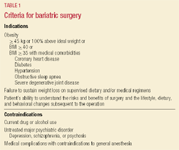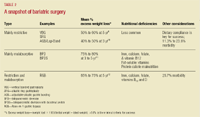Bariatric surgery and the ob/gyn patient
Weight loss surgery may increase fertility but it can also heighten her risk of nutritional deficiencies and the GI problems associated with pregnancy. As more patients seek these procedures, ob/gyns need practical guidelines for managing their care.
Obesity has become an epidemic in the United States. The prevalence of obesity (body mass index or BMI ≥30 kg/m2) has doubled from 15% to 30% in the past two decades.1 Overweight (BMI ≥25 kg/m2) and obesity are the second leading cause of preventable deaths in the US, and associated morbidities affect nearly every organ system.2 The prevalence of obesity in pregnancy ranges from 10% to 35% according to research based in Washington and Alabama, respectively.3,4 Although the best approach to obesity is prevention, treatments for obesity have become popular, especially with the recent media focus on bariatric surgery. In daily practice, ob/gyns are likely to encounter patients who have had this type procedure, since more than 80% of patients undergoing bariatric surgery are female-including many teenagers-and most are of reproductive age.

Patient selection for bariatric surgery includes a comprehensive medical, psychological, nutritional, and surgical evaluation by a multidisciplinary team. For weight loss surgery to be a success, the patient must be motivated and prepared to make lifestyle and behavioral changes. Weight loss after surgery has been shown to significantly reduce diabetes, hypertension, hypercholesterolemia, sleep apnea, stress incontinence, degenerative joint disease, and psychosocial disabilities.6-9 Even at 10 years of follow-up, patients who were surgically treated for obesity had greater rates of weight loss and physical activity and decreased morbidity rates when prospectively compared to a group of obese patients.10

Types of bariatric surgery There are two primary approaches to bariatric surgery: restriction of the gastrointestinal tract and induction of malabsorption (Table 2).11-14 Restrictive procedures reduce gastric capacity, creating early satiety and modifying eating behavior to reduce caloric intake. They include vertical-banded gastroplasty (VBG), silastic ring gastroplasty (SRG) and adjustable silastic gastric banding (AGB) (Figure 1). In 2001, the Food and Drug Administration approved the Lap-Band, an adjustable silicone band that is laparoscopically placed around the stomach just below the gastroesophageal junction. Saline can be injected into or removed from a subcutaneous reservoir connected to the band to adjust its diameter, altering the degree of restriction. The Lap-Band's long-term efficacy has not been proven.

Malabsorptive procedures cause weight loss by decreasing a patient's ability to metabolize or absorb ingested food. The first bariatric procedure, jejunoileal bypass, involved such a high degree of malabsorption and consequent potentially life-threatening complications that it has been abandoned in the US. An alternative is biliopancreatic diversion (BPD) which creates a larger gastric pouch and the biliopancreatic limb of the bypass is anastomosed with the small intestine 50 cm or more from the ileocecal valve. This procedure has the advantage of higher weight loss, but more often results in protein-calorie malnutrition, diarrhea, and deficiencies in fat-soluble vitamins and calcium. A modification of the procedure, BPD with duodenal switch, results in fewer adverse effects by increasing the length of the common intestine.
